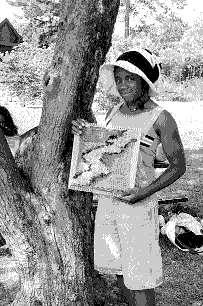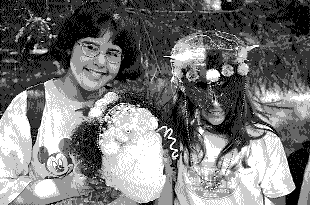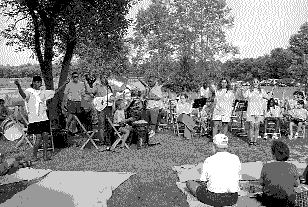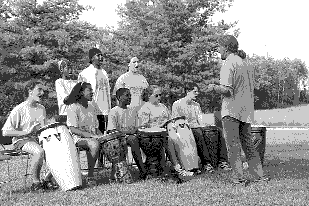|
Professor Co-creates Music/Arts
Curriculum in National Recreation Area
|
|||
|
WHEN JOANNE ERWIN, professor of music education, was asked to cowrite a curriculum for the Cuyahoga Valley National Recreation Area's summer arts camp, she had no idea that her project would become a benchmark for similar programs in national parks around the country. Erwin, along with Karen Moser, an actor involved with art education in public schools, and Megan Barness, education coordinator at the Allen Memorial Art Museum, created "River Run Earth-Arts Camp: The River's Voice" for three sessions during the summer of 1998. Using the Cuyahoga River as centerpiece, the curriculum of "The River's Voice" explores the river, its history, evolution, and its relationship to the surrounding communities to illustrate how |
Environmental Protection Agency (EPA). With the new surge of environmental awareness in 1970, there was a concerted effort to clean up the river." The River Run Earth-Arts Camp consisted of three sessions: one nine-day session for seventh and eighth grade students, and two five-day sessions for fifth to eighth grade students. Daily workshops for all sessions integrated art and performance projects exploring environmental issues. For example, local environmental artist Andy Goldsworthy sent the students into the forest to create sculptures out of materials they found in the wild. "It was really delightful to walk through the woods and come upon some mushroom-like sculpture made of twigs, mud and rocks," said Erwin. |

|
|

|
Erwin says the students enjoyed the camp experience. Some thought it felt just like school in the first session, but by the third session, the teachers turned their workshops into a much more collaborative experience and really just acted as directors for the students' creativity. The National Park Service was so impressed with the results that the River Run Earth-Arts Camp will be repeated this summer at Cuyahoga Valley National Recreation Area, and copies of "The River's Voice" will be sent to national parks across the United States as a model for summer arts camps. Erwin and her colleagues will serve as national consultants for future projects and provide teacher training. "I believe we achieved our goal for the camp," said Erwin. "Some of the students have already created environmental projects, which they completed on their own. I think they left with a greater appreciation for all of the arts, how they relate to each other, and how the arts relate to their environment. Many kids these days are apathetic about important issues like the environment. Our workshops seemed to dissipate some of that apathy and activate the students' concern for the world around them." |
||
|
civilizations affect environments. The program was created in the hope that River Run students would leave the camp with a greater awareness and appreciation of their impact upon the environment. Music, theater and movement were used as tools to connect the students to these ideas. The timeline of the study was inspired by the 1969 burning of the Cuyahoga River, which awakened people to the effects of pollution and served as a national catalyst for change and environmental advocacy. "The Cuyahoga River burned once in 1955," said Erwin. "It was terribly polluted from chemical dumping and the fire burned for days. The Cuyahoga burned again in 1969 when a spark from a train set the fire. That second fire was just one year before the founding of the |
In another workshop, campers learned environmental protest songs from the '70s, then wrote original lyrics and tunes for their own protest songs. Erwin says the songs dealt primarily with cleaning up trash, recycling and saving the land. "Learning these songs forced them not only to think about the environmental issues, but to discover and internalize their own environmental concerns through the creative process." During the drama workshop, students presented a play that depicted the characters and events of the 1969 burning, and subsequent environmental protests. Erwin also researched Native American traditions and ceremonies of the Erie Indians, known as the "cat people" because of their raccoon-like dress. Students recreated their own Iroquois ceremony, for which they built and wore raccoon masks. |
||

|
Michael Chipman, a first-year artist diploma student, studies voice with Richard Miller. Chipman received a B.A. in English literature from Utah State University. He has sung professionally with the Utah Opera and Lyric Opera Cleveland, and has soloed with the Utah Symphony, Honolulu Symphony and the Utah Chamber Orchestra. Chipman worked as a missionary in Brazil from 1991-93. |
||

|
|||